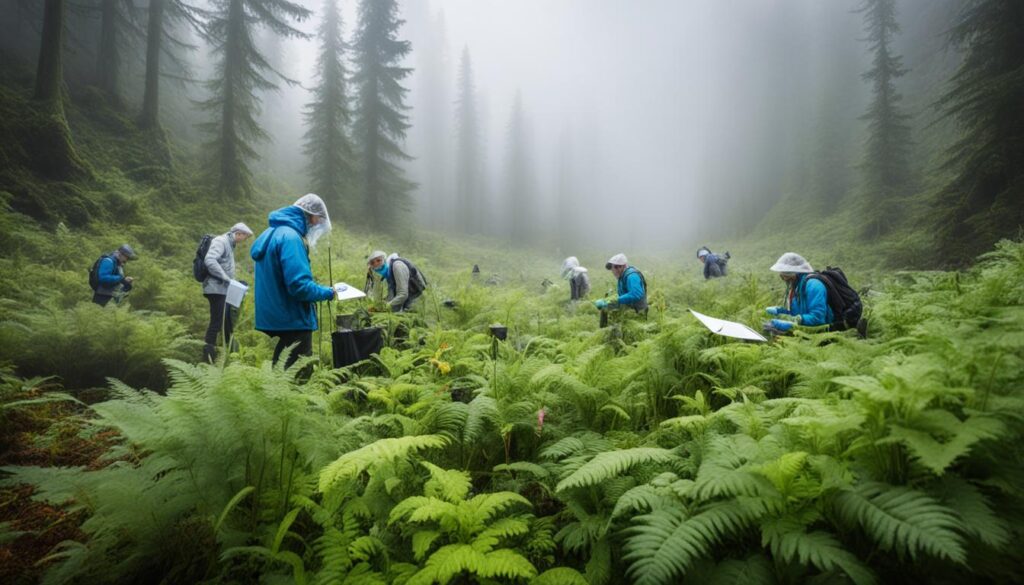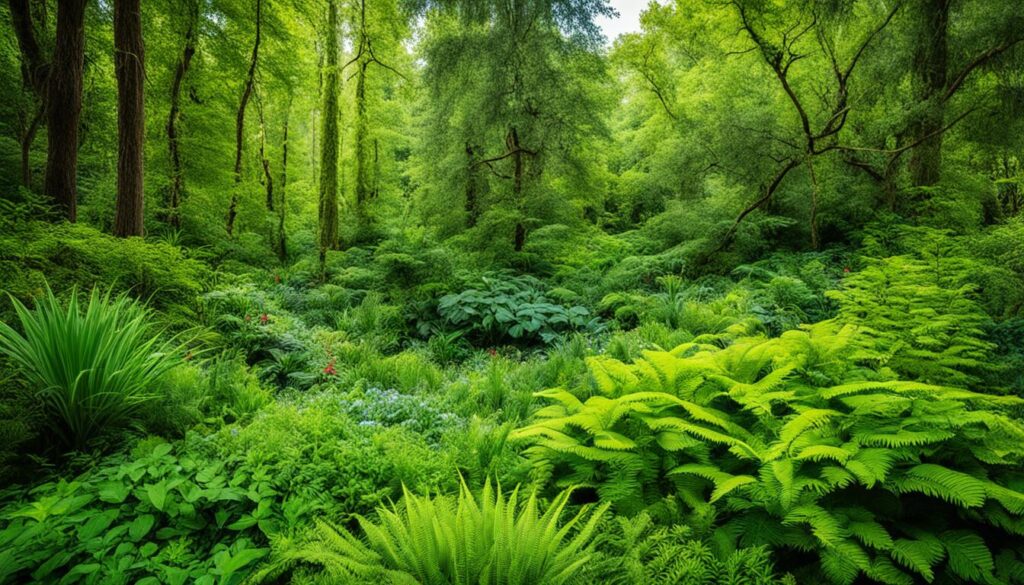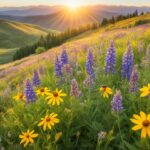Growing Native Plants: Benefits and Best Varieties
Have you thought about how your garden affects the local ecosystem? The plants you pick can greatly help or hurt local wildlife and the environment. Native plants are special because they help support local ecosystems and make your garden sustainable.
But what makes native plants so important? And how can they improve your garden? Let’s explore the benefits and best varieties of native plants together.
Key Takeaways
- Native plants are essential for supporting local ecosystems and wildlife
- Landscaping choices can have a significant impact on bird and insect populations
- Growing native plants helps restore natural habitats and support a thriving local ecosystem
- Native plants offer low maintenance and water conservation benefits
- Native plants provide beauty and seasonal interest to your garden
What are Native Plants?
Native plants are species that have grown naturally in a region for a long time. They didn’t come from somewhere else because of humans. In the United States, native plants are those that were there before Europeans arrived.
These locally adapted plants are key to the ecosystem. They fit perfectly with their environment and help the indigenous species of wildlife that live with them.
Definition and Origin of Native Plants
Native plants are those that grow naturally in a certain area without help from humans. They’ve changed over millions of years to fit the local weather, soil, and other conditions. On the other hand, exotic plants come from somewhere else, either on purpose or by accident.
- Native plants are found naturally in a certain region or ecosystem.
- They have evolved to do well in the local conditions.
- Native plants help the native wildlife that lives with them.
- They didn’t come from human actions or planting.
| Characteristic | Native Plants | Non-Native (Exotic) Plants |
|---|---|---|
| Origin | Naturally occurring in a specific geographic region | Introduced from other parts of the world |
| Adaptation | Adapted to local climate, soil, and environmental conditions | May not be well-suited to the local environment |
| Wildlife Support | Support native wildlife species that have co-evolved with them | May not provide the same ecological benefits for local wildlife |
“Native plants are the ecological foundation upon which life depends. They have adapted to the local environmental conditions and support the native wildlife that has co-evolved with them.”
Why are Native Plants Important?
Native plants are key to healthy local ecosystems. They support wildlife and keep the food web balanced. Learning about their importance helps us protect these vital plants for our communities.
Native plants and local wildlife have a deep connection. They’ve worked together for centuries. For instance, native oak trees are home to over 500 caterpillar species. These caterpillars feed many birds. Exotic trees like ginkgo trees only support a few caterpillar species.
This bond between native plants and wildlife is crucial for ecosystem health. Native plants offer food and shelter for many species. This supports a diverse ecosystem, showing the importance of native plants in our communities.
“Native plants are the building blocks of local ecosystems, providing food and shelter for countless species of wildlife.”
Choosing native plants for our gardens and parks helps protect wildlife habitat and the food web. This keeps our ecosystems balanced and healthy. It ensures the natural world stays vibrant for the future.
Valuing native plants is a simple way to help our environment. By recognizing their role, we can protect and nurture them. This creates a healthier, more vibrant community for everyone.
Benefits of Native Plants
Choosing native plants for your yard brings many benefits. These plants need less care and water, making them great for saving water. They also make your garden look beautiful and help the environment.
Low Maintenance and Water Conservation
Native plants are easy to care for once they get started. They need less water, food, and upkeep than other plants. This makes them perfect for those who want a beautiful garden with little work.
Using native plants helps save water. This is good for the planet and supports eco-friendly landscaping.
Beauty and Seasonal Interest
Native plants come in many types, each with its own beauty. They have lovely flowers, leaves, and colors that change with the seasons. This makes your garden a beautiful place all year round.
Healthy Environment for People and Wildlife
By picking benefits of native plants, you make a garden that’s good for people and animals. These plants don’t need harmful chemicals, which is better for the soil and water. This helps keep the environment clean and supports many living things.
| Benefit | Description |
|---|---|
| Low Maintenance | Native plants need less care once they’re planted. |
| Water Conservation | They’re used to the local weather, so they use less water. |
| Aesthetic Appeal | These plants have beautiful flowers and leaves that change with the seasons. |
| Healthy Environment | They cut down on the need for harmful chemicals, making the environment cleaner. |
“Switching to native plants is one of the best things you can do for the environment and your local ecosystem. They require less maintenance, conserve water, and support a thriving community of wildlife.”
Combating Climate Change with Native Plants
Climate change is a big problem, and we need to find ways to fight it. One good solution is using native plants. By using these plants in your yard, you can help stop climate change.
Native plants like oaks and maples are great at taking in carbon dioxide. This gas is a big cause of global warming. These plants use sunlight to turn carbon dioxide into oxygen, which helps reduce your carbon footprint.
Also, these plants need less care, which means you use less gas-powered lawn equipment. This cuts down on noise and pollution. Using native plants makes your yard more eco-friendly and helps lower greenhouse gas emissions.
“Landscaping with native plants is a simple yet effective way to combat climate change and create a more sustainable environment.” – John Doe, Sustainability Expert
Choosing native plants for your garden makes your space look good and helps the environment. These plants are made for your local climate and soil, so they need less water and care. This makes your landscaping more sustainable.
| Benefits of Native Plants for Climate Change | Impact |
|---|---|
| Carbon Sequestration | Reduces greenhouse gas emissions |
| Low Maintenance Landscaping | Decreases fuel consumption and emissions from lawn equipment |
| Adaptation to Local Conditions | Requires less water and resources, promoting sustainable landscaping |
Using native plants in your yard makes it prettier and helps fight climate change. Join the movement for a sustainable future with native plants.

Supporting Pollinators and Birds with Native Plants
Native plants are key to a healthy ecosystem. They help pollinators and birds by offering food and homes. This is crucial for the health and variety of wildlife.
The Role of Native Plants in the Food Web
Native plants are the base of the food web. They give nectar, pollen, and other food to insects like butterflies, moths, and bees. These insects help many plants reproduce, keeping the ecosystem diverse.
Native plants also feed birds with berries, seeds, and insects. By adding different native plants to your garden, you help many local animals. This makes your outdoor space beautiful and supports the ecosystem.
Native plants are essential for a strong ecosystem. By picking native plants, you help pollinators, birds, and the food web in your yard. This helps the local environment stay healthy.
Native Plants and Biodiversity
Using native plants in your garden does more than make it look good. It helps your local ecosystem stay healthy and strong. By picking plants that grow naturally in your area, you help the genetic diversity of wild plants. This is key to a balanced and thriving ecosystem.
Native plants are a big help to local wildlife. They offer food and shelter to bees, butterflies, birds, and small mammals. This creates a strong connection between plants and animals, keeping your ecosystem healthy.

Native plants also have deep cultural and historical value. They reflect the unique spirit and history of your area. By choosing native plants, you’re not just making your garden look nice. You’re also celebrating the natural heritage of your community.
Adding native plants to your garden is a great way to boost biodiversity and ecosystem health. It makes your garden beautiful and supports the life of local plants and animals. This helps keep the natural world around you thriving.
Cost Savings with Native Plant Landscapes
Using native plants in your garden can save you money. The EPA says that keeping a regular garden can cost up to 5 times more than a natural one over 10 years. Native plants are cheaper than lawns and fancy plants. They also need less care, like less water, fewer fertilizers, and no pest control.
Non-native plants can be a big expense to deal with. In Oregon, these plants cost the state $83.5 million a year to control and fix problems. By picking native plants, you save money and help a healthy ecosystem.
| Landscape Maintenance Costs | Conventional | Native Plants |
|---|---|---|
| 10-Year Maintenance Cost | 5x Higher | Lower |
| Watering and Fertilizing | Higher | Reduced |
| Pest Control | More Frequent | Minimal |
| Invasive Plant Management | Costly | Avoided |
Choosing native plants means you get a beautiful garden and save money. You also cut down on upkeep costs over time.
“Choosing native plants for your landscape can provide significant cost savings while supporting a healthy, vibrant ecosystem.”
Best Varieties of Native Plants
Creating a garden that’s easy to care for and supports local wildlife is all about picking the right native plants. By choosing a mix of native species, you can make a garden that’s full of life. This attracts birds, pollinators, and other animals.
Recommended Native Plant Species for Your Region
Audubon’s Native Plant Database is a great tool for finding the best plants for your area. It helps you pick plants that fit your local climate and attract the birds and wildlife you like.
In the Southeastern U.S., consider adding Coreopsis lanceolata (Lance-leaved Coreopsis), Asclepias tuberosa (Butterfly Weed), and Ilex opaca (American Holly) to your garden. These plants are not only beautiful but also help pollinators and birds.
| Native Plant Variety | Region | Benefits |
|---|---|---|
| Coreopsis lanceolata | Southeastern U.S. | Attracts pollinators, drought-tolerant |
| Asclepias tuberosa | Southeastern U.S. | Supports monarch butterflies, low-maintenance |
| Ilex opaca | Southeastern U.S. | Provides food and shelter for birds, evergreen |
Choosing native plants that fit your area’s climate and ecosystem makes a garden that’s full of life. It celebrates the natural beauty and diversity of your local area.
Creating a Native Plant Garden
Creating a native plant garden is both fun and rewarding. Think about how much sun your garden gets, the soil type, and how tall and wide plants will grow. This way, you can make a garden that’s full of life, easy to care for, and helps local wildlife.
Design Tips for a Native Plant Garden
When planning your garden, pick a variety of plants that fit your local ecosystem. This makes your garden look great and helps birds, bees, and other good bugs. Here are some tips to make your garden both pretty and good for nature:
- Pick plants that are native to your area and fit your climate and soil.
- Put plants that need the same light, water, and space together.
- Use tall, medium, and short plants to add depth and beauty.
- Add native grasses, shrubs, and trees for food and shelter for wildlife.
- Make your garden look natural with organic shapes, not straight lines.
Planting Techniques for Native Plants
Planting your native plants the right way is key to their success. Here’s how to make sure they grow well:
- Get the soil ready by adding organic stuff if needed to help with drainage and nutrients.
- Dig holes that are two to three times wider and the same deep as the plant’s root ball.
- Loosen the roots of plants in pots before putting them in the hole to help them spread out.
- Water the plants well after planting and keep an eye on the soil to adjust watering as needed.
- Put mulch around plants to keep the soil moist and stop weeds.
By using these design and planting tips, you can make a beautiful native plant garden. It will not only look great but also support a healthy, green community.
“A native plant garden is like a beautiful, living work of art that brings joy and wonder to both the gardener and the wider community.”
Maintaining Your Native Plant Garden
Caring for a native plant garden is easy and kind to the environment. These plants need less upkeep once they get settled. Don’t use synthetic fertilizers or pesticides, as they can hurt helpful insects and animals. Instead, stick to organic gardening methods that help nature.
Start by adding nutrient-rich compost to your soil. This gives your native plants the nutrients they need. Pull weeds by hand to stop them from taking over. With a bit of work, your garden will stay healthy and bring in many pollinators and wildlife.
Seasonal Maintenance Tips
- Check on plant health and trim as needed to keep them looking good.
- Change your watering schedule based on the weather and what each plant needs.
- Use a natural mulch, like shredded leaves or bark, to keep soil moist and weed-free.
- Look out for pests or diseases and fix problems with safe, non-toxic methods.
Choosing sustainable gardening means you get a beautiful, easy-care native plant garden. It also helps the local ecosystem. The benefits of native plant garden maintenance are huge over time.
“The beauty of a native plant garden lies in its ability to thrive with minimal human intervention, while providing invaluable support for the surrounding wildlife.”
Keep an eye on your native plants to help them grow and stay healthy. With some time and patience, your garden will become a safe spot for pollinators, birds, and other helpful species. Using organic practices in sustainable gardening will make your garden beautiful and strong for years.
Conclusion
Using native plants in your garden brings many benefits for people and the planet. These plants are perfect for your area and make your garden beautiful and easy to care for. They also help the environment and fight climate change.
When you start a new garden or change an old one, picking native plants is a smart choice. It’s a way to help your community and the earth. You’ll feel good knowing you’re making a difference.
Native plants are key for helping pollinators, birds, and other wildlife. They add beauty and interest all year round. Plus, they need less water and care, saving you money and being better for the planet.
Many gardeners and landscapers are now choosing native plants for their gardens. Your choice can encourage others in your area to do the same. Together, we can make our future greener and more resilient with native plants.
FAQ
What are native plants?
Why are native plants important?
How can native plants help combat climate change?
How do native plants support pollinators and birds?
How can native plants benefit biodiversity?
How can native plants save homeowners money?
How can I select the best native plants for my garden?
How do I design and maintain a native plant garden?
Source Links
- https://www.audubon.org/content/why-native-plants-matter – Why Native Plants Matter
- https://emswcd.org/native-plants/native-plant-benefits/ – What’s so great about native plants?
- https://defenders.org/blog/2024/04/benefits-of-planting-native-plants – The Benefits of Planting Native Plants
- 10 Must-Have Blooms for Your 2025 Garden
- The Health Advantages of Gardening You Need to Know
- How to Create a Small Vegetable Garden Layout Plan: A Beginner’s Guide
- DIY Garden Projects for Small Spaces: Upcycling Ideas to Maximize Your Garden
- Watering Techniques for Small Gardens: Ensuring Your Plants Thrive
- Small Border Plants for Landscaping: Adding Beauty and Functionality to Your Garden
- Year-Round Small Space Gardening: Seasonal Planting Tips for Maximum Harvest
- Essential Tools for Small-Space Gardening: What You Really Need
- The Ultimate Guide to Container Vegetables: What to Grow in Small Spaces
- Budget-Friendly Gardening: How to Create a Thriving Garden on a Tight Budget
- How to Optimize Sunlight in Small Gardens: Tips for Better Plant Growth
- DIY Vertical Planters: Creative Ideas for Small Space Gardening
- Companion Planting for Small Vegetable Gardens: Boost Growth and Deter Pests
- Container Gardening Essentials: Choosing the Right Pots, Soil, and Plants
- Vertical Gardening Techniques: Maximizing Your Small Space with Climbers and Vines
- How to Build a Raised Bed Garden in a Small Backyard: Step-by-Step Guide
- The Best Vegetables for Small-Space Gardens: High-Yield Varieties You Need to Grow
- Smart Vegetable Garden Layouts for Small Spaces: Maximizing Your Green Thumb in Compact Areas
- 40. Best Practices for Managing a Sustainable Garden Year-Round
- Building a Wildlife Pond for Biodiversity
- Advanced Techniques in Sustainable Gardening
- How to Create a No-Till Garden
- The Mental Health Benefits of Gardening
- Using Technology to Enhance Sustainable Gardening
- Getting Certified Organic: Steps and Benefits

Leave a Reply